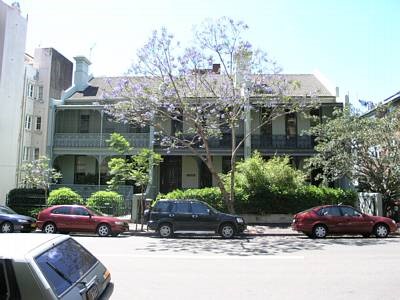HARGRAVE TERRACE, RUSHCUTTERS BAY

On a breezy morning in November, 1894, Australian explorer and gentleman inventor, Lawrence Hargrave (1850-1906), carried an elaborate kite-style contraption down onto a beach at Stanwell Park, NSW. His experiment revolutionised aviation.
This was an exciting time in the history of flight, characterised by ‘gentleman scientists’ such as Hargrave, working out of home workshops, and his own shed at Rushcutters Bay, in a global race to invent a self-powered, fixed-wing flying vehicle.
He was born in Greenwich, England, coming to Australia in 1872. In 1878 he worked at the Sydney Observatory. Thanks to his father’s prudent land purchases he had a comfortable income before he was 30. Hargrave was an inventor and explorer from an early age. Even as a young man living at Roslyn Gardens, Rushcutters Bay, originally known as “Airlie”, he often used a pair of boat-shaped boots with hinged flaps that let him walk on water!
By 1883 he’d given up paid employment to be a gentleman inventor.
He embarked on a number explorations and circumnavigated Australia. His observations of waves and of the motion of fish, snakes and birds led him to consider flight. He returned to work in an engineering workshop.
Between 1884 and 1892 he experimented with monoplanes. In 1889 he constructed a rotary airplane engine driven by compressed air and in 1892 discovered that curved wing surfaces provided more aerodynamic lift than flat surfaces. First, he invented the self-powered box kite and then, curved wings.
He had initially lived in the larger of the three houses at number 40 with his parents between 1885-1893, and then in number 44, with his family and black cat, Barbarossa, from 1899-1902, after returning from England in 1899, until they moved to Woollahra Point in 1902.
He reported his experiments he carried out at Rushcutters Bay and Stanwell Park.
On 12th November 1894, lifted himself from the beach at Stanwell Park in a four-kite construction, attached to the ground by piano wire.
He also developed a wave-propelled boat, a screw-driven engine, a working model aircraft with flapping wings, and a rotary engine so ahead of its time it was re-created by another inventor in 1908 and used in aviation for many years.
But Hargrave’s radical new wing design achieved greater lift and stability than any before it and laid the groundwork for the Wright brother’s first, motor-powered, bi-plane flight on a beach near the small village of Kitty Hawk, North Carolina, in 1903.
At the end of 1903, when he again turned to work on an engine for his flapping wings, he heard the news of the Wright brothers’ flight.
His kite models and a model of his rotary engine are held by Sydney’s Powerhouse Museum. His image appeared on the reverse side on our first twenty dollar note from 1966 to 1994. There are suggestions the proposed Badgery’s Creek Airport be named after him.
By Andrew Woodhouse, Heritage Solutions





